Exploring the link between MORF4L1 and risk of breast cancer
- PMID: 21466675
- PMCID: PMC3219203
- DOI: 10.1186/bcr2862
Exploring the link between MORF4L1 and risk of breast cancer
Abstract
Introduction: Proteins encoded by Fanconi anemia (FA) and/or breast cancer (BrCa) susceptibility genes cooperate in a common DNA damage repair signaling pathway. To gain deeper insight into this pathway and its influence on cancer risk, we searched for novel components through protein physical interaction screens.
Methods: Protein physical interactions were screened using the yeast two-hybrid system. Co-affinity purifications and endogenous co-immunoprecipitation assays were performed to corroborate interactions. Biochemical and functional assays in human, mouse and Caenorhabditis elegans models were carried out to characterize pathway components. Thirteen FANCD2-monoubiquitinylation-positive FA cell lines excluded for genetic defects in the downstream pathway components and 300 familial BrCa patients negative for BRCA1/2 mutations were analyzed for genetic mutations. Common genetic variants were genotyped in 9,573 BRCA1/2 mutation carriers for associations with BrCa risk.
Results: A previously identified co-purifying protein with PALB2 was identified, MRG15 (MORF4L1 gene). Results in human, mouse and C. elegans models delineate molecular and functional relationships with BRCA2, PALB2, RAD51 and RPA1 that suggest a role for MRG15 in the repair of DNA double-strand breaks. Mrg15-deficient murine embryonic fibroblasts showed moderate sensitivity to γ-irradiation relative to controls and reduced formation of Rad51 nuclear foci. Examination of mutants of MRG15 and BRCA2 C. elegans orthologs revealed phenocopy by accumulation of RPA-1 (human RPA1) nuclear foci and aberrant chromosomal compactions in meiotic cells. However, no alterations or mutations were identified for MRG15/MORF4L1 in unclassified FA patients and BrCa familial cases. Finally, no significant associations between common MORF4L1 variants and BrCa risk for BRCA1 or BRCA2 mutation carriers were identified: rs7164529, Ptrend = 0.45 and 0.05, P2df = 0.51 and 0.14, respectively; and rs10519219, Ptrend = 0.92 and 0.72, P2df = 0.76 and 0.07, respectively.
Conclusions: While the present study expands on the role of MRG15 in the control of genomic stability, weak associations cannot be ruled out for potential low-penetrance variants at MORF4L1 and BrCa risk among BRCA2 mutation carriers.
Figures




References
-
- Wang W. Emergence of a DNA-damage response network consisting of Fanconi anaemia and BRCA proteins. Nat Rev Genet. 2007;8:735–748. - PubMed
-
- Meindl A, Hellebrand H, Wiek C, Erven V, Wappenschmidt B, Niederacher D, Freund M, Lichtner P, Hartmann L, Schaal H, Ramser J, Honisch E, Kubisch C, Wichmann HE, Kast K, Deissler H, Engel C, Muller-Myhsok B, Neveling K, Kiechle M, Mathew CG, Schindler D, Schmutzler RK, Hanenberg H. Germline mutations in breast and ovarian cancer pedigrees establish RAD51C as a human cancer susceptibility gene. Nat Genet. 2010;42:410–414. doi: 10.1038/ng.569. - DOI - PubMed
-
- Vaz F, Hanenberg H, Schuster B, Barker K, Wiek C, Erven V, Neveling K, Endt D, Kesterton I, Autore F, Fraternali F, Freund M, Hartmann L, Grimwade D, Roberts RG, Schaal H, Mohammed S, Rahman N, Schindler D, Mathew CG. Mutation of the RAD51C gene in a Fanconi anemia-like disorder. Nat Genet. 2010;42:406–409. doi: 10.1038/ng.570. - DOI - PubMed
-
- Crossan GP, van der Weyden L, Rosado IV, Langevin F, Gaillard PH, McIntyre RE, Gallagher F, Kettunen MI, Lewis DY, Brindle K, Arends MJ, Adams DJ, Patel KJ. Disruption of mouse Slx4, a regulator of structure-specific nucleases, phenocopies Fanconi anemia. Nat Genet. 2011;43:147–152. doi: 10.1038/ng.752. - DOI - PMC - PubMed
Publication types
MeSH terms
Substances
Grants and funding
LinkOut - more resources
Full Text Sources
Other Literature Sources
Medical
Molecular Biology Databases
Research Materials
Miscellaneous

